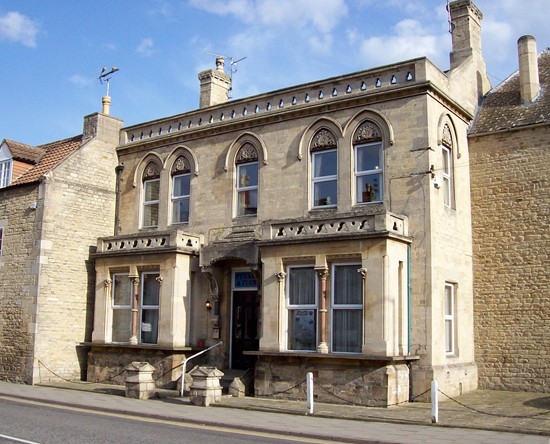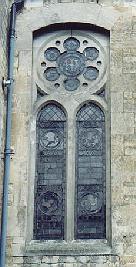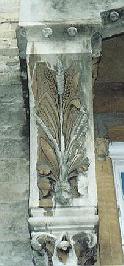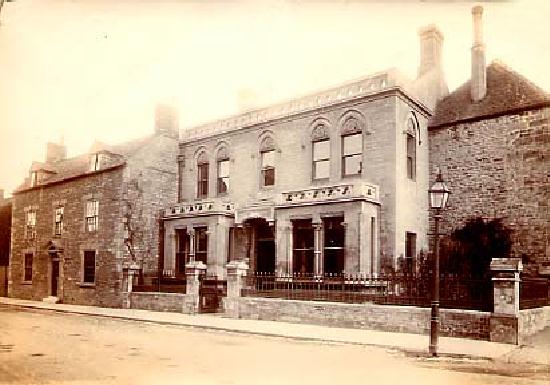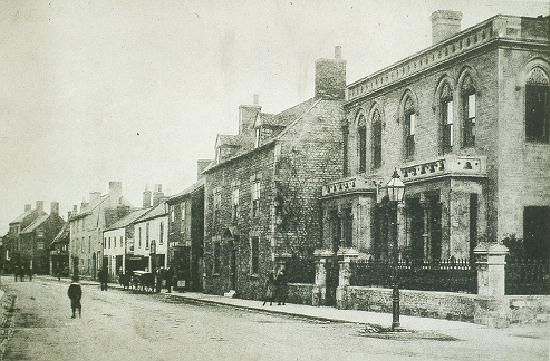|
The Bourne Institute
The imposing building on the corner of St Peter's Road is a perfect example of Victorian ostentation. No 63 West Street was once a farmhouse but its wealthy owner during the 19th century gave it a Gothic style façade. The porch contains ballflower decoration and wheat sheaf capitals while the date 1872 has been included in the arch rosette above the upper window on the side of the front and the owner’s initials J G are also visible to the discerning eye in a similar position above the upper central window.
The public meeting was well attended and it was unanimously decided to call the new organisation the Bourne Institute and that it be conducted on non-sectarian and non-political lines by a popularly elected committee, the objects being to make provision for healthy recreation, education and mutual intellectual improvement, and providing facilities for a wide range of social activities including a music room with a piano, musical and debating societies, billiards and other games, and a modest library. A proposal to this effect was moved by Mr Robert Gardner, who presided at the meeting, and in seconding his motion, the Rev G H Bennett, minister at the Baptist chapel, expressed cordial approval and added: "There can be no doubt as to its necessity and I predict that it will be successful. I therefore welcome its formation on behalf of the young people of the town and I hope that a library will also be provided." Running costs were estimated at £80 a year and initial expenses £45, in addition to the cost of a billiards table and other fixtures. The Bourne Institute therefore came into being and opened at the premises in West Street the following month, in November 1896, with Mr Gardner as president. In the event, the library became one of the most popular amenities and every effort was made to extend the available stock. On Tuesday 2nd May 1897, a novel idea was successfully carried out by the library committee when a concert was organised with a book as the admission charge. The club president, Robert Gardner, was the first to respond with two handsome volumes of the Norwegian explorer Fridtjof Nansen's The Farthest North and a total of 150 books were presented in this way, thus forming the nucleus of the library. Later that year, Mr William Younger, MP for the Stamford division which included Bourne, and a keen supporter of the Institute, presented the complete set of recently published volumes on The Queen's Prime Ministers. The generous gift was announced at the start of a three-day bazaar on Friday 11th June, held as part of the committee's appeal for books and which raised £160. The event was opened by Sir William E Welby-Gregory who praised the social, educational and intellectual advantages of the Institute that were now becoming apparent. In a short space of time, the library had amassed 400 books, a remarkable collection at a time when they were prized possessions and eagerly sought after by those anxious to read and expand their knowledge of the world. The debating society was another popular feature of the Institute's activities, robustly discussing a wide range of current topics, both local and national, such as the session on Friday 11th February 1898 when a crowded meeting heard impromptu speaking on various subjects including the imposition of a tax on cycles, Britain's role in retaining Egypt, socialism and whether a time limit should be imposed on Parliamentary speeches. There was also an active theatrical section, in particular the Bourne Institute Amateur Minstrels, who specialised in giving concerts consisting of songs, dances, monologues and sketches, performed by actors wearing black face make-up and under the direction of a chairman, a form of entertainment that has disappeared in recent years because of political correctness. A typical production by the group was given at the Corn Exchange on Tuesday 22nd February 1898, when the musical director was Mr W R Leary, a local music teacher who was also organist and choirmaster at the Abbey Church, and a report of the evening in the Stamford Mercury the following Friday gives us a flavour of the time: The minstrels gave a capital entertainment in aid of the Institute purchase fund. The overtures introductory to parts 1 and 2 went splendidly under Mr W R Leary's able conductorship, Mr Arthur Lumby being leader and soloist. The programme was varied, interesting, full of bright melodies, interspersed with happy, original and mirth-provoking jokes. Mr G N Bryant made an excellent interlocutor [chairman] and the corner-men (Messrs E Landsdown "Tambo", F G Wall "Bones", J R Heywood "Pete" and J Brudenell "Pompey"), were full of vivacity and bye-play of rollicking fun. The choruses deserve special praise for precision, tone and effect. Mr Lumby's violin solo was in itself high-class fare to lovers of the artistic and delicately expressive interpretation of good music. His technique was perfect and his admirable performance elicited the heartiest applause from all parts of the house. Professor Karl Haydn gave a wonderfully clever conjuring performance. His skill will undoubtedly bring him a more than provincial success. The solos went remarkable well, the audience frequently evincing their emphatic approbation. Mr Williamson's song in character was a great hit. The farce Rum 'uns from Rome was a first-rate piece of fun. The characters were sustained with spirit and the abundant points which the piece afforded were fully utilised. The performers had evidently bestowed great care on the work (and this is true of the entire entertainment), and thoroughly deserved the hearty appreciation bestowed upon their efforts.
The premises were rented initially on a three-year lease but in 1897, the committee was given the opportunity to buy the building. John Gibson was still the owner at that time but he was in financial difficulties and had been declared bankrupt. To add to his problems, he had also been charged with fraud, having tried to obtain goods on credit, and so what assets he had were being realised to pay off his creditors, including the building which was then being used by the Bourne Institute. A series of fund raising functions began with a bazaar to mark Queen Victoria's Diamond Jubilee under the patronage of the Countess of Ancaster. It was held on Wednesday 9th June and was a grand occasion for the 200 members which was marked by the issue of a Bourne town guide as a souvenir of the event, published by Mr John Thomas Pearce, proprietor of a stationery shop in the Market Place that also specialised in books and printing. The bazaar was opened by Mr William Younger, the Stamford MP, who was taking an active interest in the Institute, and in his speech, he gave members an insight into the development of similar organisations throughout the country. "Institutes such as this", he said, "have become a necessity of the times and in large towns they are the means of accomplishing very useful work and are therefore highly appreciated. Young people who have been closely confined during working hours at the desk or in the shop wish for opportunities where they can both secure social enjoyment and improve their minds. Mr Balfour [Arthur James Balfour, Conservative politician and Prime Minister from 1902-05], seeing the value of similar enterprises, has said that the literary power of the next twenty years will be in the artisan class. The inhabitants of Bourne are not favourably situated for enjoying literary advantages, as they are in the midst of a purely agricultural district. But in this Institute, they will find opportunities of spending their leisure time with pleasure and profit. Of course, Institutes like this cannot be started and carried on without money and I trust that during the continuance of this bazaar, sufficient money will be forthcoming to set your minds at rest as to your financial position. When Queen Victoria acceded to the throne in 1837, books were very scarce and very expensive and the bulk of the people were unable to read; now, the power of reading is, thanks to popular education, universal. Books are plentiful and so cheap that the poorest have opportunities of enjoying them. Hence, there is more need for the formation of a correct literary taste which can be fostered in a place like this Institute where the best literature of the day is available." Unfortunately, the weather was bad for the opening and plans to hold the bazaar in a large marquee in the grounds were abandoned and the stalls were set up in the billiards room and granary as a result. All had been decorated in red, white and blue to mark the Diamond Jubilee and during a concert in the evening, a series of tableaux were staged to illustrate the leading events in the Queen's reign. There was also music, songs and dancing and as the weather improved, decorated gondolas took guests on short trips along the Bourne Eau. The money raising continued and in 1899, the Institute was able to purchase the property for £900. Donations of almost £330 were received towards the cost and £600 was borrowed at an interest rate of 3½ per cent but an appeal for a further £350 was launched to pay for pressing repairs to the building. The success of the project became apparent at the annual general meeting of the Institute held on Tuesday 30th January 1900 when Mr Gardner was re-elected as president with Mr J W Eason as honorary secretary and Mr T Carlton, treasurer. It was reported that the assets of the Institute were £1,090, being a balance of £459 9s. 10d. over the liabilities and Mr Gardner told the meeting: "This handsome block of buildings, splendidly adapted for the purpose, are now the property of the Institute and during the year, the value has been enhanced by their being put into a thorough state of repair. Every department of the Institute shows activity and progress. The membership is 187 and we confidently hope that this might well be increased to 300 very soon." The ladies were now being welcomed as members of the Institute and participating in the wide variety of social and cultural activities and many took part in a typical event that was held on Tuesday 21st February 1899 when the Stamford Mercury reported: A very pleasant "debate social" evening took place in the Music Room of the Institute. The room was artistically decorated and a capital spread of good things provided by the ladies. Excellent instrumental selections were given by the members of the Bourne Orchestral Society. Songs were contributed by the Misses Grummitt, Lansdown and Mr Lansdown, Mr A E K Wherry being accompanist. A glee was beautifully rendered by Mrs Eason, Miss Lansdown, Mr Lansdown and Mr Gee. A duologue, "Shattered Nerves", was very cleverly given by Miss Bell and Miss Gibson. A strict code of conduct applied to all members using the premises and anyone who transgressed the rules of good behaviour were likely to be hauled before the committee. The old minute books that have been preserved record several such instances and in one case two members were banned from the premises for three months for "unacceptable behaviour in the reading room", although what they did was unspecified, while another member was banished for being found out of bounds in the ground floor room reserved for use by the ladies. The first billiards table was bought in 1900 and a second in 1908 and this began the tradition for the game on these premises that exists today. During the Great War, injured soldiers sent to Bourne for treatment at the Vestry Hall in North Street that had been turned into a temporary military hospital, were given honorary membership of the Institute in order that they could enjoy the facilities as part of their rehabilitation. A miniature rifle range was established in a granary building adjoining the Bourne Institute buildings in 1902 that was used by Bourne Rifle Club and for firing practice by the Bourne Volunteers during the Great War of 1914-18. In 1921, Mr Gardner was presented with an antique jardinière to mark his 25 years as president, an office he held until his death in 1926 when he bequeathed a generous endowment to help the institute pay off the outstanding balance on its mortgage of the premises. The golden jubilee was celebrated in October 1946 with a gathering at the Corn Exchange when tribute was paid to six people who had been appointed honorary members in honour of their staunch support and continuing work. They included Mr Gardner's niece, Mrs Ernestine Dunbar, Mr F E Wherry (president), Mr C C MacLeod, Mr W J Matthews (secretary), Mr F C Parker (treasurer) and Miss M K Pearce, whose father, the late Mr E Pearce, had held at various times the offices of president and treasurer. Major Cecil Bell, who had recently died and had been a member of the original committee, was also remembered together with his sister, Miss A Bell, who had been connected with the institute since its inception and was still a member of the library committee. In July 1953, the committee approved leasing one of its rooms to Kesteven County Council for use as a branch library for Bourne at an initial rental of £1 a week and although the original agreement was for a five-year period, it continued until the town's present library was opened in South Street in 1969. In 1975, the Bourne Institute was renamed the Pyramid Club that flourishes today, an organisation owned by its members whose activities are devoted mainly to billiards and snooker, as the name implies, but the owners resisted the temptation to spoil this grand frontage with gaudy advertising signs.
THE BOURNE INSTITUTE IN PAST TIMES
Two photographs of the institute, one dating from circa 1900 (above)
See also The Pyramid Club
Memories of the Bourne Institute Bourne rifle range
Go to: Main Index Villages Index
|
|||||||||
